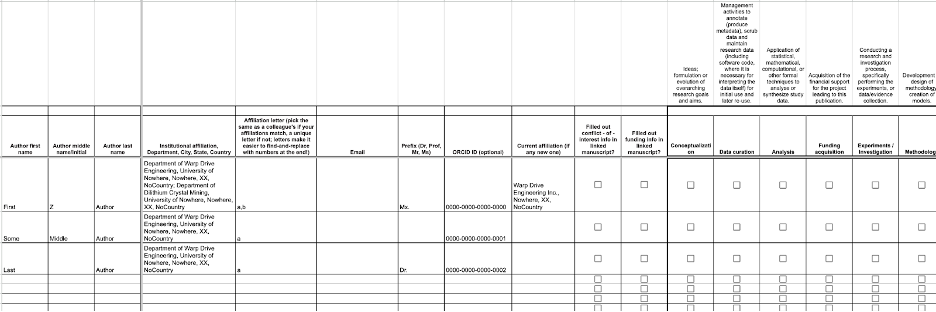Beth Cimini
In the Imaging Platform, we tend to work on a lot of big, complicated projects, with a lot of moving pieces and sometimes collaborators in many countries! This is fantastic for science, but when it comes to writing a paper, it can make just gathering all the information about "who did what" a nightmare.
We've now organized a couple different large projects using the CRediT contribution system for tracking author contributions towards various papers, and in general it has worked really nicely (H/T to QUAREP WG 12 for introducing me to this system, as part of this awesome project)! CRediT makes it easy to figure out who did what in a structured way, which helps with defining the many kinds of contributions folks have made (even some you may have forgotten you made or not realized it was a contribution!). To help it scale, we prefer to have each author fill out their own row, which we realized was massively facilitated by having it as a Google Sheet (or any other editable cloud shared file, as you prefer). We initially built this for ourselves, but we hope it helps the community, so we've made a blank template copy anyone can copy and use! Go to the File menu and then either make a copy, or download to use in Excel* or move to your favorite online fileshare.

The last few columns past the actual CRediT columns we typically keep hidden until the table is done, but they're some of my favorite; one of my least favorite things when submitting a paper (or putting it on a CV, or what have you) is how every platform seems to want to have author names formatted in a different way. Tucked away there at the end are therefore some hidden script columns to transform names easily across several common formats. The second-to-final column is an "author order" column - once you've had your authors fill out the table and authorship order is decided, you simply put the numerical order of the authors, and then use the column to sort the rest of the sheet (hover over the column header until a down arrow appears, click it, and then click "Sort sheet A to Z"). You can then order the affiliations (by find-and-replacing the first letter in the sorted author with 1, the next with 2, etc), and then you're all set to go**. The last column lists each author's contributions, if your journal likes that style. Happy collaborating, and let us know what you think!
Edit 1, August 2023: If you want to know more, please see the follow-up column I wrote for Nature's Career Columns series about this tools and large collaborative project work in general!
Edit 2, January 2024: Added the new last column with initialed author contributions, after seeing another great version of a CRediT sheet, this one from Bioimaging North America. Also, this blog post now has a Zenodo DOI, if citing is your thing! The column has one as well.
*=In my hands, when downloaded to Excel, the sheet is initially cranky in the formula columns- the initial "TEXTJOIN" gets changed to "@TEXTJOIN" for some reason. If you remove the phantom "@" and then just propagate the change down, it works with no problem.
**="But, Beth, why aren't the numbers in the last columns superscripts, like they typically need to be?"
I know, it bugs the heck out of me too, but Google Sheets doesn't support font operations in formulas. I played for a while with using the unicode versions of the characters, but TLDR, the numbers 1-3 are either a different size or position depending on the font you use, and it's ugly; it will work best to just do the superscripting in your final word processing program.
